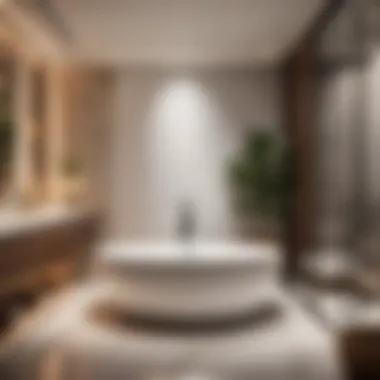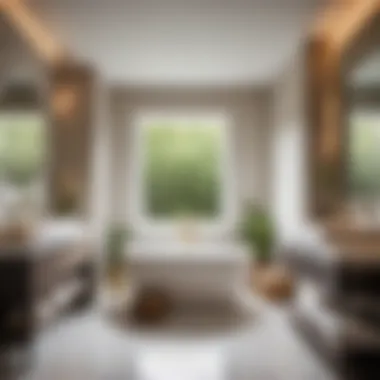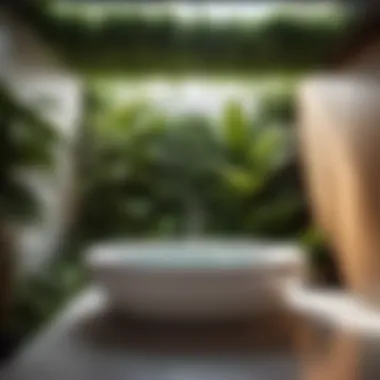Ultimate Guide to Efficiently Incorporating a Deep Tub in a Small Bathroom


Materials:
- Deep tub (exact measurements: 60" length, 30" width, 20" depth)
- Waterproof sealant
- Tile adhesive
- Tiles for tub surround (exact measurements: 12" x 12")
- Grout
- Backer board
- Screws
- Drill
- Level
- Caulk
- Waterproof membrane
DIY Steps:
- Prepare the Space: Clear out the bathroom area where the deep tub will be installed. Measure the available space to ensure proper fitment.
- Install Backer Board: Cut the backer board to fit the tub surround area. Securely attach it to the walls using screws and a drill.
- Apply Waterproof Membrane: Coat the backer board with a waterproof membrane to protect the walls from water damage.
- Tile Surround: Using tile adhesive, install tiles onto the backer board as the tub surround. Ensure a precise fit and use a level to keep tiles straight.
- Grout Tiles: Fill in the gaps between tiles with grout. Wipe off excess grout with a wet sponge for a clean finish.
- Install the Deep Tub: Carefully put the deep tub into place within the tiled surround. Seal the edges with waterproof caulk for added protection.
- Final Touches: Apply a waterproof sealant around the tub to prevent leaks and add a polished look to the installation.
Technical Aspects:
- Timing Specifics: Allow 2-3 days for the waterproof membrane, adhesive, and caulk to fully dry and set.
- Tools Needed: A drill, level, trowel for adhesive, grout float, wet sponge, and caulking gun for precise application.
- Critical Techniques: Ensure all tiles are properly aligned and grouted for a seamless finish. Use a quality waterproof sealant to protect the installation from water damage.
DIY Project Process:
- Measurement Precision: Accurate measurements are key to a successful deep tub installation. Double-check all dimensions before cutting materials.
- Tile Placement: Take your time when placing tiles to ensure a uniform and visually appealing tub surround.
- Sealing Techniques: Apply waterproof sealant generously and uniformly around all seams and edges to prevent water seepage.
- Troubleshooting Tips:
- If tiles do not adhere properly, reapply adhesive and press firmly.
- For grout that dries too quickly, mist with water to extend workable time.
- In case of uneven tiles, gently adjust while adhesive is still wet for accurate positioning.
Introduction
In the realm of home design and renovation, the significance of efficiently incorporating deep tubs into small bathrooms cannot be overstated. This article delves into the challenges and solutions for maximizing space and functionality while maintaining a stylish ambiance with the inclusion of a deep tub. Whether you seek enhanced relaxation or improved functionality within limited space, this guide will provide you with a detailed blueprint for achieving these objectives seamlessly.
Significance of Deep Tubs in Small Bathrooms
Enhanced relaxation and comfort
Enhanced relaxation and comfort play a pivotal role in transforming the bathroom into a haven of tranquility. The deep tub offers a sanctuary where one can unwind after a long day, immersing oneself in a sea of soothing warmth. This feature not only enhances personal well-being but also elevates the bathing experience to a luxurious realm. The unique depth of the tub enables complete immersion, promoting ultimate relaxation and comfort that traditional tubs cannot match. Its ergonomic design ensures optimal neck and back support, allowing for prolonged soaks without discomfort.
Improved functionality within limited space


Within the constraints of a small bathroom layout, functionality is often compromised. Deep tubs, however, present a solution by maximizing space efficiency without sacrificing usability. Their compact yet deep structure allows for a luxurious bathing experience while requiring minimal floor space. This innovation in design demonstrates how functionality can be seamlessly integrated into limited space, offering a practical and aesthetic solution for small bathrooms.
Challenges Faced in Small Bathroom Layouts
Lack of space for traditional tubs
One of the primary challenges in small bathroom layouts is the lack of sufficient space for traditional tubs. Conventional tubs are often bulky and occupy substantial floor area, making them impractical for compact bathrooms. The depth and size of deep tubs address this issue by providing a space-efficient alternative that does not compromise on comfort or style. Their sleek design and compact footprint allow for optimal utilization of space, catering to the spatial limitations of small bathrooms.
Difficulty in balancing aesthetics and functionality
Achieving a harmonious balance between aesthetics and functionality poses a significant challenge in small bathroom layouts. The struggle to marry visual appeal with practicality can lead to compromised design choices. Deep tubs serve as a versatile solution by combining aesthetic allure with functional excellence. Their elegant contours and contemporary finishes enhance the visual appeal of the bathroom while meeting the practical requirements of a bathing space. By seamlessly integrating style and usability, deep tubs offer a holistic approach to design that overcomes the dilemma of balancing aesthetics and functionality in small bathrooms.
Selecting the Right Deep Tub
In the quest for optimizing bathroom space with a deep tub, selecting the right tub takes center stage due to its pivotal role in balancing functionality and aesthetics. The deep tub serves as the focal point of the bathroom, combining practicality with luxury. When choosing the perfect deep tub, homeowners must consider various critical factors to ensure it complements the small space effectively.
Considerations for Size and Dimensions
Measurements to fit the bathroom layout
When it comes to dimensions, precise measurements are paramount in ensuring the deep tub seamlessly fits within the limited space of a small bathroom. The size of the tub should align with the bathroom layout to avoid any overcrowding or disproportionate appearance. By meticulously measuring the available space and considering the tub's dimensions, homeowners can optimize the layout to create a harmonious and functional bathroom design. While larger tubs may offer a more luxurious bathing experience, they might not be practical for compact bathrooms. Therefore, striking the right balance between size and available space is crucial for maximizing comfort and functionality within the constraints of a small bathroom.
Depth for optimal soaking experience
The depth of the deep tub is a paramount consideration for homeowners seeking an indulgent bathing experience. Opting for a deep tub with the right depth ensures that users can enjoy a relaxing soak while maximizing comfort. A deeper tub allows for submersion up to the shoulders, promoting a spa-like ambiance and providing therapeutic benefits. Moreover, the depth of the tub contributes to the overall visual appeal and functionality of the bathroom, making it a vital element in the selection process. While deeper tubs offer enhanced relaxation, they may require more water to fill, leading to increased water consumption. Therefore, homeowners should weigh the benefits of depth against water efficiency to make an informed decision that aligns with their preferences and sustainability goals.
Types of Deep Tubs
Soaking tubs
Among the types of deep tubs available, soaking tubs stand out for their immersive bathing experience and elegant design. Soaking tubs are renowned for their deeper basin, allowing users to fully submerge and unwind after a long day. The key characteristic of soaking tubs lies in their generous depth, surpassing standard tubs to provide a luxurious soaking experience. This makes soaking tubs a popular choice for homeowners looking to enhance relaxation and create a spa-like atmosphere within their small bathroom. However, the main disadvantage of soaking tubs is their potential space consumption, requiring careful integration into the bathroom layout to preserve functionality and aesthetics.


Japanese-style deep tubs
Japanese-style deep tubs, also known as Ofuro tubs, offer a unique bathing experience inspired by traditional Japanese rituals. These deep tubs prioritize depth over length, allowing for a deep soak while conserving space in compact bathrooms. The key characteristic of Japanese-style tubs is their compact size and deep basin, reflecting simplicity and minimalism in design. This distinctive feature makes Japanese-style deep tubs a beneficial choice for homeowners seeking a blend of functionality and cultural elegance in their bathroom. However, the compact size of these tubs may pose limitations for taller individuals, requiring consideration of user comfort and space utilization during the selection process.
Freestanding deep tubs
Freestanding deep tubs exude sophistication and versatility, making them a popular choice for modern bathroom designs. These tubs stand independently of any surrounding structures, allowing for creative placement and flexible installation in small spaces. The key characteristic of freestanding deep tubs is their aesthetic appeal and visual impact, serving as a focal point in the bathroom layout. This unique feature enhances the overall ambiance and style of the bathroom, creating a luxurious retreat for homeowners. While freestanding tubs offer flexibility in design, they may require additional floor space and support for installation, necessitating careful planning to optimize space utilization and achieve a seamless integration into the small bathroom environment.
Space Optimization Strategies
In the realm of small bathrooms, space optimization strategies play a crucial role in making the most of limited square footage. These strategies are vital in ensuring that every inch is utilized effectively to incorporate a deep tub without making the space feel cramped. By intelligently planning and implementing space optimization techniques, homeowners can achieve a harmonious balance between functionality and aesthetics in their bathroom design. With a focus on maximizing efficiency, selecting smart storage solutions, and enhancing the overall appeal of the space, space optimization strategies act as the backbone of this article.
Vertical Storage Solutions
Shelving above the tub
Shelving above the tub is a key component of vertical storage solutions that offer a practical and visually appealing way to maximize space utilization in a small bathroom. By installing shelves above the tub area, homeowners can utilize the vertical space effectively, creating storage solutions for items like towels, toiletries, and decorative elements. The prime advantage of shelving above the tub lies in its ability to free up floor space while providing easy access to essential items within arm's reach during relaxation sessions. Its unique feature of blending storage with design makes it a popular choice for those looking to optimize their bathroom space efficiently.
When considering shelving above the tub in this context, homeowners should be mindful of the weight-bearing capacity of the shelves, ensuring they are securely installed to avoid any accidents. While the shelving adds functionality and style to the space, it may require periodic maintenance and cleaning to prevent dust accumulation and maintain a pristine look.
Hanging organizers
Hanging organizers offer a versatile solution for storing various bathroom essentials while saving precious floor space. These organizers come in a range of designs, from simple racks to multi-tiered baskets, allowing for customization based on individual storage needs. By hanging organizers on bathroom walls or doors, homeowners can keep items like haircare products, toiletries, and other daily necessities well-organized and easily accessible.
The key characteristic of hanging organizers lies in their ability to declutter surfaces and keep the bathroom tidy, enhancing the overall functionality of the space. Their popularity stems from the convenience they provide in organizing smaller items that might otherwise clutter countertops or cabinets. Despite their benefits, homeowners should consider the weight capacity of the organizers and ensure proper installation to prevent overloading and damage to the walls.
Compact Fixture Selection
Wall-mounted faucets


Wall-mounted faucets represent a pragmatic choice for small bathrooms seeking to optimize space and streamline the aesthetic appeal of the area. By mounting faucets on the wall near the deep tub, homeowners can free up valuable countertop space while retaining full functionality. The key characteristic of wall-mounted faucets is their ability to create a sleek and modern look while offering practical benefits such as easy cleaning and maintenance.
This selection is a beneficial choice for this article as it aligns with the theme of maximizing space efficiency without compromising on style. The unique feature of wall-mounted faucets lies in their ability to enhance the visual appeal of the bathroom by creating a clean and uncluttered look. However, homeowners should be aware of potential installation complexities and ensure proper sealing to prevent leakage and water damage.
Corner sinks
Corner sinks stand out as a smart and space-saving fixture selection for small bathrooms, especially when paired with a deep tub to maximize functionality within a constrained area. Placing a sink in the corner of the bathroom not only optimizes space but also creates a seamless flow in the layout. The key characteristic of corner sinks is their ability to make use of underutilized corners, making them a popular choice for compact bathroom designs.
The benefit of corner sinks in this context lies in their ability to complement the deep tub installation seamlessly, allowing for a cohesive and efficient bathroom layout. While corner sinks offer advantages in space optimization, homeowners should consider the plumbing requirements and accessibility for maintenance when selecting this fixture. Proper installation and sealing are crucial to prevent any leakage issues that may arise from the proximity to the tub.
Functional and Aesthetic Integration
Functional and Aesthetic Integration is a pivotal aspect when incorporating a deep tub into a small bathroom. In this article, we emphasize how the fusion of functionality and aesthetics plays a crucial role in maximizing the space efficiency and creating a visually appealing bathroom setting. By blending practicality with design elements, homeowners can achieve a harmonious balance that elevates the overall ambiance of their bathroom.
Lighting and Ambiance
Strategic Lighting Placement
Strategic lighting placement is a fundamental consideration in optimizing the functionality and aesthetics of a bathroom space. By strategically positioning lights around the tub area, homeowners can create a soothing ambiance and highlight the deep tub as a focal point in the room. The key characteristic of strategic lighting placement lies in its ability to enhance the visual appeal of the tub area while providing sufficient illumination for a relaxing bathing experience. This approach is popular for its ability to transform a small bathroom into a luxurious retreat, where lighting plays a significant role in enhancing the overall mood and comfort of the space. However, it's essential to carefully plan the placement to avoid glare or shadows that may disrupt the relaxing atmosphere of the bathroom.
Mirror Illusions for Spacious Feel
Using mirror illusions to create a spacious feel is a clever design technique that can be highly advantageous in small bathrooms. By strategically placing mirrors to reflect light and expand visual perceptions, homeowners can visually amplify the size of the bathroom, making it appear larger and more open. The unique feature of mirror illusions lies in their capacity to trick the eye into perceiving additional space, making the bathroom feel more expansive and airy. While this approach can vastly improve the overall ambiance of a small bathroom, it's crucial to consider the placement of mirrors to avoid overwhelming the space with reflections or causing visual distortion. Despite its effectiveness in creating a sense of spaciousness, overdoing mirror illusions can lead to an exaggerated and artificial feel, detracting from the desired aesthetic cohesion of the bathroom.
Conclusion
In the realm of optimizing bathroom space by incorporating a deep tub in a small bathroom, the conclusion plays a pivotal role in summing up the core principles and benefits discussed throughout this article. It is crucial to acknowledge that achieving a perfect balance between functionality and aesthetics is key when tackling space constraints. By following the strategies and considerations outlined in the previous sections, one can transform a small bathroom into a multifunctional and visually appealing sanctuary.
Achieving the Perfect Balance
Efficient Use of Every Inch
Efficient use of every inch refers to the art of maximizing space within a small bathroom while ensuring every corner serves a practical purpose. This approach involves strategic planning and utilization of compact fixtures such as wall-mounted faucets and corner sinks to optimize available space. The key characteristic of efficient use of every inch lies in its ability to transform seemingly wasted areas into functional storage or design elements. This method is beneficial for small bathrooms as it allows for efficient organization without sacrificing on style or comfort. While the advantages include enhanced storage options and a clutter-free environment, potential disadvantages may involve restricted flexibility in layout modifications due to fixed installations.
Elevating the Bathroom Experience
Elevating the bathroom experience encompasses the enhancement of both functionality and ambiance to create a spa-like atmosphere within a limited space. This aspect focuses on upgrading lighting choices and incorporating mirror illusions to amplify the perception of spaciousness. The key characteristic of elevating the bathroom experience is its ability to elevate everyday routines into luxurious experiences. This approach is popular among individuals aiming to create a relaxing retreat within their own homes. By integrating thoughtful lighting placements and visual tricks, this strategy aims to enhance both the visual appeal and mood of the bathroom. While the advantages include creating a more enjoyable bathing environment and improving overall well-being, potential disadvantages may involve the need for additional planning and investment in high-quality fixtures and lighting solutions.







